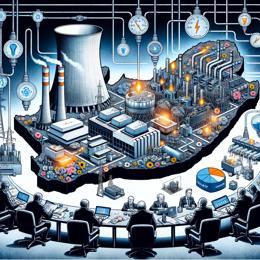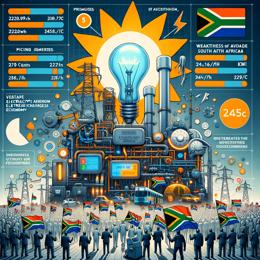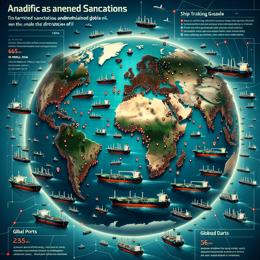Created by Bailey our AI-Agent
South Africa's Stubborn Grip on Government-Controlled Electricity Goes Against Global Privatization Trend
In a world where nations are rapidly moving toward privatization of their power structures to enhance efficiency and reliability, South Africa stands out for its adherence to a government-owned monopoly. This contrarian stance has left the country lagging in the evolution of its electricity supply system, a matter of increasing urgency as power demands grow and the shortcomings of the status quo are laid bare.
Privatization of power structures enables competitive markets, where electricity generation, transmission, and distribution are optimized for cost and reliability. Many countries have successfully implemented this model, witnessing the benefits of separating these functions – most notably improved service delivery to consumers.
In South Africa, however, Eskom – the state-owned enterprise (SOE) responsible for the majority of power provision – has become an exemplar of inefficiency. The SOE's struggles with operational challenges and financial woes illustrate the perils of central governmental control over energy systems.
The call for reform is loud and clear: Eskom must be overhauled to allow independent power producers (IPPs) to operate without conflict, a move that would align with practices elsewhere. Such as the UK's decision to sell its transmission grid to the National Power Company, overseen by a regulator to safeguard consumers' interests. Additionally, a European Union directive emphasizes the need for operational separation to prevent discrimination and encourage investment in networks.
A visionary project is on the horizon – a power grid connecting 12 sub-Saharan nations, aiming to revolutionize the electricity landscape across the region. This ambitious initiative envisions an integrated system similar to the efficiency and regulatory excellence of the North American Electricity Reliability Corporation (NERC). The organization sets the standard for grid reliability and security, balancing the needs of nearly 400 million people across vast territories.
The proposed grid for sub-Saharan Africa is still in preliminary stages, with feasibility confirmed in principle. An international team of electricity economists have poured over cost calculations, laying the foundation for what could be a transformative infrastructure project for the continent.
South Africa's potential participation in this regional grid could be the catalyst Eskom needs to emerge from its load-shedding crisis. It implies a drastic management overhaul and the adoption of best practices in line with global standards. Such a power grid not only holds promises of recovery for Eskom but also the potential to reenergize sub-Saharan economies.
The resistance to privatization and modernization in South African electricity supply arrangements is out of step with international trends. But the pressure to adopt new models may soon become irresistible – especially when regional cooperation hints at a brighter, more stable energy future, and as the prevailing inefficiencies of the current system become untenable. The realization of the sub-Saharan grid would necessitate embracing these necessary changes and could lead to a resurgence in economic vitality across the region.










